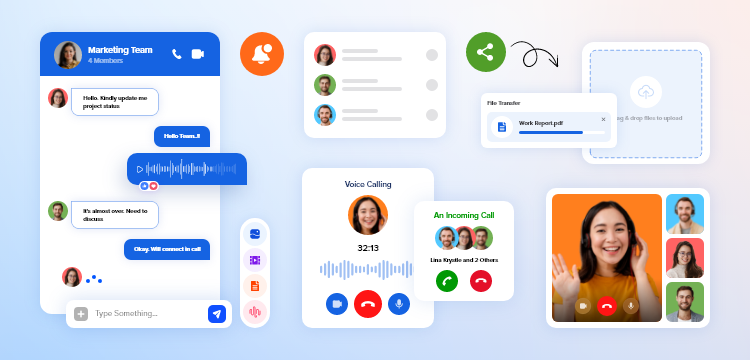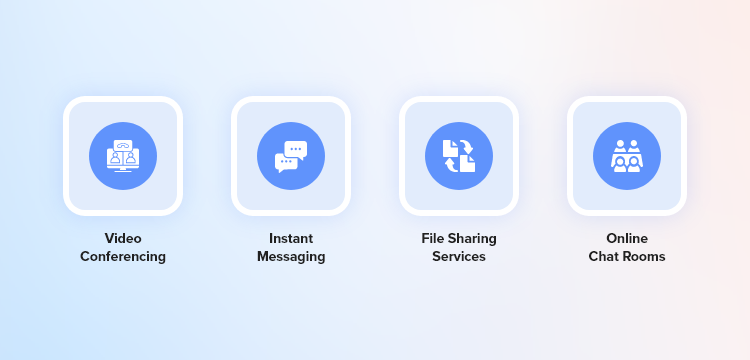Workplace Communication: How To Implement In Your Business?

Workplace communication is crucial because it helps people understand each other, work well together, and feel heard. It builds a positive environment, enhances teamwork, and ensures everyone is on the same page, making the workplace more effective and enjoyable.
This article focuses on:
- What exactly is workplace communication?
- Why does your company need an effective communication system?
- Tools that connect your remote workforce
- Steps to implement workplace communication
Well, let’s begin.
Table of Contents
What Is Workplace Communication?
The term “workplace communication” describes the means by which people in an organization exchange their ideas and information with one another. This includes a variety of channels, including calls, notes, texts, and emails.
What Changed The Way Teams Communicate?

Before COVID-19, people used to go to offices regularly. They interact with teams in person and sometimes travel to client locations to get businesse done.
But, the pandemic had a significant impact on businesses throughout the world, causing a dynamic shift towards remote work.
Although certain places have resumed in-person work routines in recent times, it looks like the hybrid work model is probably here to stay for a while.
This clearly emphasizes the need for businesses to focus on effectively managing virtual communications at work to maintain employee outcomes.
Why Is Communication Important In Workplaces?

Imagine that you are running a company and your team is working remotely. You need to send out an important instruction to your team that is highly time-sensitive.
Now, it is not a good idea to call each person or meet them in person to instruct them. Rather, you need a system that connects all of you to keep things running smoothly.
So here are some of the circumstances that demonstrate why workplace communication is super-important:
1. Avoid Misunderstanding & Confusion in Daily Task
Imagine your workplace being a bit messy because your team often gets mixed up about what they’re supposed to do each day. This mix-up causes them to miss important deadlines, and things start feeling a bit chaotic.
The main issue is that important messages are getting lost in a flood of emails, and really important updates are getting missed.
MirrorFly Pro Tip:
Use a dedicated team chat app where you can create separate channels for each project. Keep your team active with updates and questions so everyone stays in the loop.
2. Make Remote Working Efficient
As more people are working from different locations, a new problem arises: teams are finding it difficult to stay connected and well-informed.
The traditional way of working, where everyone is in the same office, makes it easy to talk and share information. But with remote work becoming more common, team members are not physically together, and this creates challenges.
MirrorFly Pro Tip:
This is where you need to use video conferencing to make your team feel more connected and ensure that important information is shared efficiently in a remote work setting.
3. Eliminate Project Bottlenecks
Picture a situation where the work your team is doing gets stuck, and everyone starts feeling a bit frustrated. The main reason behind this frustration is that the way people are talking to each other is not very quick or smooth.
When communication is slow, progress naturally slows down too. It becomes tough for team members to figure out what they need to do next or how to solve problems together.
This situation is not just about the work getting delayed; it’s also about everyone on the team feeling a bit stuck and annoyed because things are not moving as smoothly as they should.
MirrorFly Pro Tip:
To solve this, use a chat channel to speed up discussions and problem-solving, ensuring that the team can get things done without unnecessary delays.
4. Improve Employee Inclusivity
Imagine a situation where employees are not feeling very happy because it seems like nobody is paying attention to their ideas. They’re putting forward suggestions, but it’s like their thoughts are being overlooked or ignored.
This makes the employees feel a bit downhearted and left out, and as a result, they start losing some of the excitement they once had about their work.
When ideas are not discussed or acknowledged, it creates a sense that what employees have to say isn’t valued.
This lack of recognition can lead to a decrease in morale, and over time, people may become less eager to share their thoughts or contribute creatively.
MirrorFly Pro Tip:
To tackle this issue, you need to create a space where employees can freely talk about their ideas. This way, team members feel appreciated, their contributions are recognized, and the workplace becomes a more positive and engaging environment.
5. Easily Handle Urgent Situations & Delays
Imagine a situation where something really important happens, and the news about it takes too much time to reach the people who need to know.
The usual ways of talking to each other just don’t seem to work well in these urgent situations. Because of this, the team faces delays in finding solutions and fixing problems promptly.
MirrorFly Pro Tip:
To solve this, use a chat channel to speed up discussions and problem-solving, ensuring that the team can get things done without unnecessary delays.
Tools To Improve Workplace Communication

Using different tools can make it easier for people at work to talk to each other. This helps them work together better, get more done, and create a positive and happy work atmosphere. Here are some of the tools and technologies that improve the communication within an office/ company.
1. Video Conferencing:
Video conferencing is essential for real-time communication between teams that work from different locations. This technology in fact adds a human touch to every conversation that employees make via their devices.
People could see each other, share ideas and ensure that their meetings are valuable enough to get tasks done. Also, it saves a lot of time by cutting off the need to travel from one location to another.
2. Instant messaging:
Instant messaging is undoubtedly a boon to organizations. You can simply communicate with team members through direct messages rather than making phone calls/ meeting in person for the simplest of things.
Employees can get quick replies and connect via dedicated group chat for their teams for conversations that do not necessarily require a meeting.
3. File Sharing Services:
Yet another important reason where people need to collaborate is when they need to access work files. Teams can use file sharing services or their own team chat apps to share files with each other.
On the other hand, sharing files within the organizational ecosystem ensures that important files and tasks are handled confidentially without any third-party intervention.
4. Chat rooms:
Organizations can conduct webinars and conferences via chat rooms easily, and even automate onboarding and offboarding processes by integrating these communication tools into their workflow, ensuring seamless transitions for employees.
Conclusion:
As we wrap up the article about better ways to communicate at work, think about this: you can actually create your own chat app! It’s not as tricky as it sounds, especially when you use an SDK like MirrorFly.
MirrorFly makes building a team chat app super easy. You can have video meetings, send messages instantly, share important files, and create chat rooms for your team talks. What’s great is that MirrorFly isn’t just packed with 150+ features & 100+ UI components, it’s also easy to use, so you won’t need to write lengthy codes from scratch for months.
Why consider MirrorFly? Well, it’s not just about what it can do – it’s how it makes your work life better. It grows with your team, you can customize it to fit your brand’s style, and it’s reliable when you need it most.
So, why not give it a shot? Jump in, check out MirrorFly, and see how it can turn your work chats into something awesome. Give MirrorFly a try today!
Frequently Asked Questions:
To make work communication better, it’s not just about speaking clearly. You also need to really listen when others talk. Focus on what they’re saying, and if you don’t get it, ask questions. Tell them what you think, too, so everyone understands each other. And don’t forget to use different ways to communicate, like messages or emails, depending on how important or urgent the information is. That way, you make sure everyone’s on the same page.
Effective communication reduces the chances of mistakes and creates a positive work environment. When communication is strong, it promotes collaboration and improves overall workplace satisfaction.
Good workplace communication goes beyond just conveying information. It involves clarity, transparency, and empathy. It means not only expressing your thoughts clearly but also actively listening to others. It’s about creating an atmosphere where everyone feels comfortable sharing ideas and concerns.
When you talk with your team, it’s important to be really clear in your messages. Use words that everyone can understand. Also, listen carefully to what your teammates say and try to see things from their point of view. And when you need to share information, pick the right tool for the job, like sending emails, messages, or having meetings. This way, you make sure everyone gets the info in the best way possible.
Workplace communication can take various forms. Meetings provide a platform for in-depth discussions, emails are suitable for formal communication, messages facilitate quick updates, phone calls offer direct conversations, and face-to-face chats add a personal touch when necessary. Selecting the appropriate method depends on the context and the information being conveyed. Each method serves a different purpose and can enhance overall communication effectiveness in the workplace.
Related Articles:
- Top 11 Communication Solutions For Your Business Apps In 2024
- 10 Best Instant Messaging Platforms for Business 2023 | MirrorFly
- How To Build a Real-Time Chat App for iOS and Android?
- Top 10 Business Instant Messaging Software in 2024
Ready To Build Your Own Custom Chat App?
Get our enterprise-grade communication solution, that can be set up on your company servers.
Contact Sales100% customizable
White-label solution
Full source code

Hello guys,
Why don’t I ask for the flaws? Okay this blog is informative but could you tell me what are some common communication mistakes to avoid in the workplace? This question will turn your user experience in good terms.
Common communication mistakes to avoid in the workplace include poor listening, lack of clarity, using jargon excessively, not asking for feedback, and not being mindful of non-verbal cues. Effective communication fosters productivity, teamwork, and positive relationships among colleagues.
Hi,
This is Ruskha, What are some common communication challenges in the workplace, and how can they be addressed? if possible you can explain here!
Hello Ruskha,
Common communication challenges in the workplace include misinterpretation, language barriers, and differing communication styles. Address these by promoting active listening, providing clear guidelines for communication, offering language training, and fostering a culture of respect and understanding among team members.
Hi Team Fly,
This blog is so descriptive, how can I ensure that remote or distributed teams communicate effectively?
To ensure effective communication in remote or distributed teams, utilize collaboration tools such as video conferencing, instant messaging, and project management software. Establish clear communication protocols, schedule regular check-ins, encourage transparency, and foster a culture of trust and open communication among team members.
Hello people,
Keep posting this kind of informative things, will you tell me what are the key components of effective workplace communication?
The key components of effective workplace communication include clarity, active listening, empathy, transparency, and feedback. Clear and concise messages, combined with attentive listening and understanding of others’ perspectives, promote collaboration, reduce misunderstandings, and foster a positive and productive work environment.
Hello,
Thanks for sharing this kind of informative thing, what role does diversity and inclusion play in workplace communication?
Hello Telson,
Thank you, Diversity and inclusion foster richer perspectives, encouraging open dialogue, understanding, and respect. They enhance communication by embracing varied experiences and creating a more inclusive, cohesive work environment.
Hello Team fly,
Can anyone tell me how can I improve communication among employees?
Hi Anish,
here I have declared some points kindly check that,
Hi team,
This blog is so informative, how can a business sustain effective communication practices in the long term?
hi Hellen,
here is your answers,
Hi,
I’m Sheela sang, Could you tell me that how communication is important in the workplace?
hi Sheela,
Of course communication is important for some several reasons, It fosters teamwork, ensuring everyone is on the same page and working towards shared goals. Clear communication reduces errors, minimizes misunderstandings, and boosts productivity. It also enhances employee morale, encouraging a positive work environment where ideas flow freely, feedback is valued, and relationships are strengthened, ultimately leading to better outcomes and success for the organization.